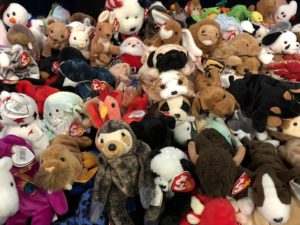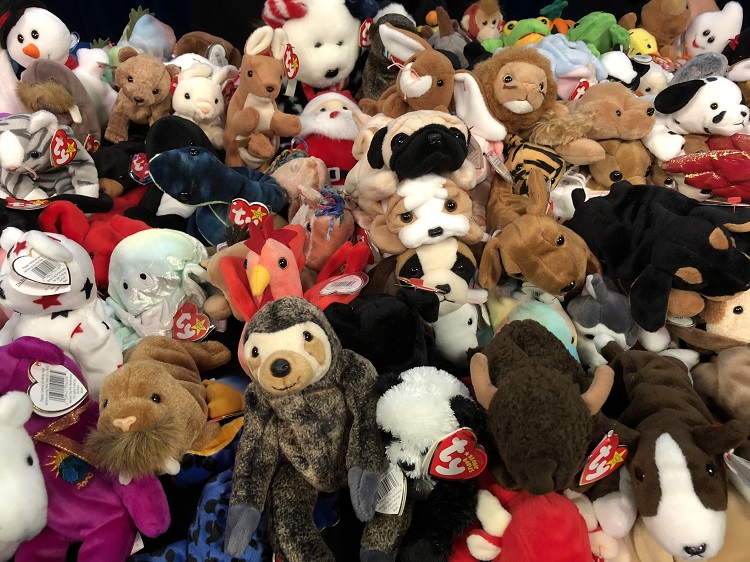
Do you know how to spot real value in the popular Beanie Babies marketplace? Here are three tips that will show you how to identify the real from the fake.
1. Learn the Lingo
You may have a basket, plastic tote, or box full of beanie babies stuffed toys in all shapes and sizes dating back to the 1990s in your closet, storage locker, attic, or basement. You have heard conflicting reports about their value–based on varied information from questionable sources–based on colors, names, birth dates, tags, logos, errors, etc. You don’t know what to think.
The first thing to know when evaluating beanie babies is the lingo… the heart shaped swing tag (or hang tag or ear tag as they are called) and the fabric tush tag (or buttocks tag or butt tag) can be found attached to the stuffed toy. Tags were designed and redesigned. For a short period of time, the swing tag served double duty as a gift tag with blank spaces for To: and From: to be filled out. These tags give information about the origin of the beanie baby. Often the tags show a birth date, a place or places of manufacture, and of course, a name for the darling little collectible. Learn the lingo surrounding beanie babies and don’t be fooled by the many, many, many imitators.
Misspellings were common as were incorrect information on tags and changes to names or birth dates also occurred with the knowledge of the manufacturer. It is a myth that all of the beanie babies with any type of error or misspelling are worth very high values. Learn the difference between the names of similar looking beanie baby toy animals like Tabasco the bull with all red feet and a very similar bull toy named Snort who looks very much the same but has all white feet. This change took place because the Tabasco name was protected by the makers of Tabasco sauce. Tabasco the bull’s name was changed to Snort by Ty Inc. to avoid trademark infringement suits.
Counterfeit Beanie Babies began to surface in 1997. There were counterfeit beanie babies produced including those based on Squealer the Pig, the Princess Diana purple bear to support the Princess Diana memorial fund, Brittania bears, and others during the late 1990s as the collecting craze was in full swing. Do you have a real or a fake? Show me during a video chat so I can tell you. Schedule a chat now.
Other lawsuits were waged against Ty Inc., the makers of beanie babies toys, which impact the collectability of the toys on the market. For instance, Garcia, the tie-dyed bear, resembled the mascot of the band, The Grateful Dead. The beanie baby bear was born on August 9, 1995 which was the same date when musician Jerry Garcia died according to the toy’s tag. But, Ty Inc. did not have rights to the Garcia name and the tie-dyed beanie baby was retired after a lawsuit was filed against the company by Garcia’s family. This notoriety impacted the value and interest in the bear as it did with other beanie babies with collectors.
Licensed beanie babies of the early 2000s were produced in the likeness of Dora the Explorer, Sponge Bob Square Pants, Scooby Doo, Mickey Mouse, and more recently, PAW patrol, Peppa Pig, and others.
2. Condition is Critical
Remember the basics when considering the value of any collectible toy. Condition is always key to value but when it comes to beanie babies, it is not all that easy to assess the condition of one of the toys. Most people think that the beanie babies they have owned since the early 1990s are all in great shape since they only played with them a few times and then stored them away in a plastic tub for years. Well, when it comes to beanie babies, collectors are very persnickety –and they should be– about condition.
With beanie babies, the condition must be excellent which means no dirt, stains, losses, tears, intact tags, no writing on the tags, no losses, and most importantly, no settlement of the “beans” or interior PVC or PE pellet material stuffed inside each toy animal or figure.
Beanie Babies are deliberately under-stuffed. This allowed the toys to take on various poses. There is a difference between an under-stuffed beanie baby and one whose pellets have settled on the inside. If you want to see if there has been settlement on your beanie baby, then sit the toy upright on a flat surface, like a kitchen table, shelf, or desk, if the head is falls to one side or the stomach looks as if there is excess skin, then settlement has occurred and this is a condition flaw. Most people overlook this type of condition assessment but truly informed collectors won’t miss it. Condition impacts the value of the overall collectible toy.
Also, when it comes to assessing condition of a beanie baby toy, the hang and tush tags must match each other with the same date, place of origin, and character name. Sometimes, the two dates conflict or are not the same and you will see that the hang tag has one date and the tush tag has another different date. And, if someone stained or dirtied the stuffed beanie baby toy or if someone wrote on the paper hang tag or tush tag, then that impacts value of the toy negatively too.
Packaging of beanie babies and miniature beanie baby toys called Teenie Beanies starting in 1996 are important for those collecting advertising beanie babies toys like those offered in McDonald’s Happy Meals and those associated with 1990s and early 2000s movies or major sporting events or sports teams. Some beanie babies toys were marketed with licensing deals from pro sports teams which can impact value of these select stuffed toys from the late 20th/early 21st Centuries.
3. Provenance
The most valuable beanie babies like other collectible toys must have an established background or provenance which is why Princess Diana Memorial Fund beanie babies are valued higher in value than some of the other beanie baby stuffed toys. These purple Princess Diana beanie babies relate to a major historical figure of the 20th Century and to the British royal family. Princess Diana’s legacy even touched young people who collected the toys so that is one reason why that particular beanie baby is so coveted and sought after in the market. Others, based on their provenance and popularity also have significant value like the nine original beanie babies. See the list of the nine original beanie babies. I also talk about these and other valuable beanie babies in my videos where you can see the valuable ones up close.
Some other important beanie babies, just to name a few, are Valentino, Millennium bear, Peace bear, among many others. If you have some of these popular and highly valued beanie babies in your collection or you are thinking of selling them, be sure to keep like toys together as a group, if you can. Also, look for minor differences like various colored noses on the same animal or figure beanie baby, nuances on printed tags or errors, appearance or existence of minor accessories like hats, scarves, bows, etc. This information could confirm or deny provenance so be sure that all of the information about that beanie baby you are considering for purchase matches the provenance information.
Provenance is also important if you want to sell a particular beanie baby for top dollar. Consider this: If you own a beanie baby toy with unquestionable provenance and you can prove it belonged to some major 1990s pop icon like Brittany Spears or Justin Timberlake, then that beanie baby is worth more than one owned by someone who is not famous but how just came of age during the 1990s when the beanie baby craze was in full swing. Establishing the background of a beanie baby is not easy to do so be sure to address the other factors that impact value, like condition and origin, when purchasing beanie babies for your own collection.
Do you need help identifying and valuing your beanie babies? I help people with one or tubs of them. You can send me unlimited photos to review using my Priority Ask Dr. Lori subscription or schedule a FaceTime or Skype call to show them to me. I’ll be happy to help.




